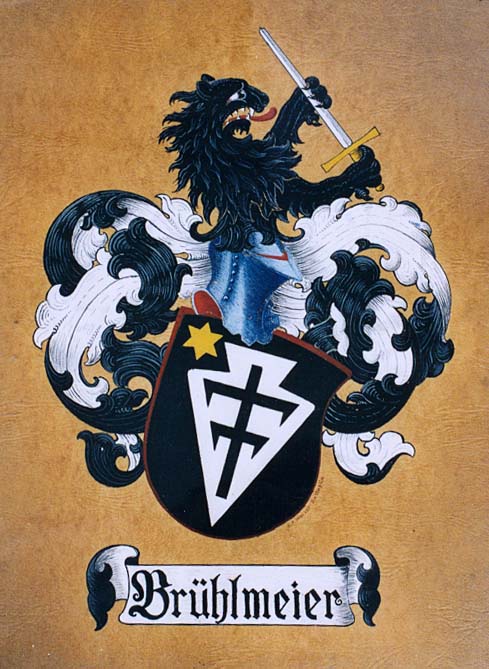The Insignia of the Bruehlmeier Family
It is undeniable that the Bruehlmeier’s originally did not have an insignia, nor did any other gender of Wettingen, because only the nobles were allowed to carry an insignia and it was explicitly prohibited to the Wettinger farmers by the abbey. Nevertheless, two insignia currently exist and both were probably created around the same time, but independent of each other, during the forties of the 20th century. I am designating them with the name of the heraldry specialists who created them, namely, Heinrich P. Walser-Battaglia of Neuenhof and J. Magg of Biel.
The Walser Insignia

Walser-Wappen 1945
The children of Josef Bruehlmeier-Spoerri (FT 192; I am one of them) gave their father a hand-painted insignia as a Christmas present in 1966 and contacted the heraldry specialist who had created the insigna, H. Walser, thanks to information from the state archive of Aarau. According to the note dated November 1966 which accompanied the insignia, the (female, but not stated by name) client entrusted the heraldry specialist H. Walser in fall 1945 with research regarding an insignia for the Brühlmeier’s and respectively with the creation of a new insignia. My own research shows that the client was Susanne Suter, who wanted to give her fiancé Eduard Brühlmeier (FT 293) a family insignia as a Christmas gift in 1945. In the handwritten text of the founding certificate, we can learn the following about the insignia:
„The coat of arms shows a white plow upside-down on a black background, covered by a black brand mark resembling a double cross and is accompanied by a yellow hexagonal star in the upper right corner of the shield. The plow , which is painted in a natural, white color, stands for the husbandry which was the main activity of the ancestors of the insignia’s founder for centuries, as they were farmers in Wettingen. The black brand or house mark (in the same color) is a delivered brand mark which was used in earlier times by a family Meier in Wettingen (from the Bohuesli-line). With this sign, the family marked their gear, tools, carriages, cattle, etc. Since the “Bruehlmeier’s” are a branch of the ancient “Meier”-family and even a line of the branch of the “Bohuesli-Meier”, this brand mark can be used unobjectionably by the insignia’s founder. The star on this insignia is taken over from the star in the insignia of Wettingen, which in turn was taken over from the insignia of the abbey, since the village of Wettingen belonged to the property of the abbey Wettingen for centuries. This star shall insinuate the right of citizenship of Wettingen held by the Bruehlmeier family. May a star of fortune shine on all members of the Bruehlmeier family and all its branches from now on.“
In the 1966 letter accompanying the insignia, Walser explains the following, in addition to the information just stated… “The undersigned has submitted a sketch of the insignia described above to the Argovian State Archive, which included it in their collection because no other insignia had been submitted before, the insignia conforms with heraldic rules and because it is not an appropriation of another insignia. Since then, this insignia is the only coat of arms of the Bruehlmeier family which will be reported upon request.”

The Walser insignia of 1966
Other owners of the Walser insignia are the family Stefan and Beatrice Bruehlmeier-Schibli and the family Otto and Anna Sprecher-Bruehlmeier. They have received it from the state archive.
The Magg Insignia

To my knowledge, two originals exist of the Magg insignia and both originate from the house of Hans Bruehlmeier-Lienberger (FT 85). One today is in the possession of the family Bernhard and Ida Spoerri-Bruehlmeier (FT 101 and FT 100), and the other one is the exemplar owned by Hans Bruehlmeier himself and was then passed on as part of the legacy to my brother Werner Bruehlmeier-Schaad (FT 205).
Very much in contrast to the work of H. Walser, J. Magg, heraldry specialist of Biel, left only a few lines in the letter accompanying the insignia and had not even dated his sheet. I am most thankful to the couple Spoerri-Bruehlmeier for taking good care of this note. Thanks to it, we can learn the following:
Chronicle of the Brühlmeier Family
Old family from Wettingen which was documented for the first time in the 17th century. The name is a description of a place of residence, it is a derivation from “Meier of the Bruehl”. – Source: From Gatschet – Collection of Coats of Arms, 1799.
So I started looking for the book where this quote had been taken from in several libraries and archives, until finally, a member of the E-Mail list of the Swiss genealogical society referred me to the “Foundation for Swiss Coat of Arms and Banners”. The president of this foundation, Joseph Melchior Galliker informed me that the work I was looking for is the book of coat of arms by Niklaus Gatschet from 1799, which is in possession of the Burger library in Bern. In this library, I found this very large, colored handwriting in two volumes, in which Gatschet had properly documented each and every coat of arms of patricians and nobles of the canton of Bern. I realized immediately that no Bruehlmeier could be found in this book. Nevertheless, there was once a Bernese patrician called “von Bruehl”. Magg took this coat of arms as a basis for his new insignia for the Bruehlmeier family, and painted only two shamrocks in the white perpendicular band instead of the seven like in the original. This also makes it understandable why he did not write “Meier in the Brühl” in his short report (as it would be correct), but “Meier of the Brühl”.
Clearly, this approach is another valid method of getting an idea for a new insignia. While Walser founded his idea on genealogical and local historical facts, Magg was inspired rather by the sound of the name “Bruehl”. One also has to admit, this insignia is aesthetically very pleasant and completely fulfills the purpose of serving as a family insignia. However, it has not been submitted to the state archive in Aarau, which is why later friends of coat of arms will probably prefer the Walser insignia over the Magg insignia.
Conclusion
I am putting this work into the hands of a small group of interested persons, very much aware of the fact that it is mainly a skeleton, to which a lot of flesh could still be added. Quoting the head of the state archive, “Family research is like eating cheese fondue: The more you try to get out of it, the more strings you will pull.” There is only one remedy for this: One needs to cut the strings if one does not want to get caught up in them. The most important strings I had to cut to avoid being caught for the rest of my life with family research are the following:
-
I have only partly discovered where the Bruehlmeier’s lived during the 18th and 19th century, which farmyards or goods they managed and how they could keep up financially. Someone would have to dig more deeply and thoroughly through all of the handwritten Urbar’s, depot books, indices of plats and manufacturing protocols, which fortunately are still around for the time in question.
-
It would also be intriguing to find out about the education or professional training of the older Bruehlmeier’s.
-
Also, the ancestors of Martin Meier (FT 885) remain to be discovered. So far, Spiegelberg’s statement that he was a Bohuesli remains the only clue we have.
-
The development of the family in the 16th century could also be researched with more focus. In order to get results in this area, one would probably have to look intensely in the court files of the Landvogtei of Baden and in the files of the abbey.
-
Two intriguing questions remain to be solved: When and where did Kaspar Bruehlmeier and Rosina Beetschen meet? And why did Kaspar Bruehlmeier-Steimer move to Fribourg and what did he do there?
-
What also remains is the broad field of exploring interesting facts of the lives of members of our family who are still alive or who spent a large part of their lives in the 20th century.
-
And finally, I have collected only a few graphic materials. A more thorough genealogist would hardly abstain from entering portraits of all adult members of our family into the computer.
At any rate, I am hereby closing my work, but I am available for spontaneous messages or findings from any source, which I will then document in my computer. Possibly someone can be found with a historical interest and who will carry on the further research of our family.

